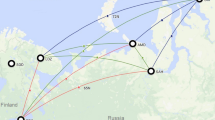Abstract
The behavior of the HF signal parameters during magnetic storms and substorms has bee experimentally studied simultaneously on the Kiruna-Kirkenes auroral path, Kiruna-Longyearbyen polar path, and Murmansk-St. Petersburg subauroral path. The first two paths are equipped with the instruments making it possible to measure the values of the signal-to-noise ratio, Doppler frequency shift, and elevation angle. The method of oblique sounding of the ionosphere (OSI) was used on the Murmansk-St. Petersburg path. Two substantial substorms, a moderate storm, and an intense storm occurred during the studied period. Some new regularities have been revealed. On the Kiruna-Kirkenes and Kiruna-Longyearbyen paths, the signalto-noise ratio increased (due to the transition from the F 2 signal reflections to the E s reflections), the elevation angle increased (due to an increase in the ionospheric F 2 layer height and a decrease in the critical frequency), and the Doppler shift increased (due to the variations in ionization and the appearance of ionospheric irregularities during a substorm) when the signal was reflected from the F 2 layer close to the moment of the substorm or storm beginning T 0. It is possible to control the so-called “main effect” in the ionosphere on the Murmansk-St. Petersburg path.
Similar content being viewed by others
References
M. J. Angling, P. S. Cannon, N. C. Davies, et al., “Measurements of Doppler and Multipath Spread on Oblique High-Latitude HF Paths and Their Use in Characterizing Data Modern Performance,” Radio Sci. 33(1), 97–107 (1998).
D. V. Blagoveshchensky, T. D. Borisova, and L. V. Egorova, “Pre- and Poststorm Situations in the Ionosphere and Propagation of Decameter Radiowaves,” Geomagn. Aeron. 36(4), 125–134 (1996) [Geomagn. Aeron. 36, 508–514 (1996)].
D. V. Blagoveshchensky and T. D. Borisova, “Substorm Effects of Ionosphere and HF Propagation,” Radio Sci. 35(5), 1165–1171 (2000).
D. V. Blagoveshchensky, J. W. MacDougall, and A.V. Piatkova, “Ionospheric Effects Preceding the October 2003 Halloween Storm,” J. Atmos. Solar-Terr. Phys. 68(11), 821–831 (2006).
D. V. Blagoveshchensky, L. V. Egorova, and V. M. Lukashkin, “High-Latitude Ionospheric Phenomena Diagnostics by High-Frequency Radio Wave Propagation Observations,” Radio Sci. 27(3), 267–274 (1992).
D. V. Blagoveshchensky, M. Lester, V. A. Kornienko, et al., “Observations by the CUTLASS Radar, HF Dopple, Oblique Ionospheric Sounding, and TEC from GPS during a Magnetic Storm,” Ann. Geophys. 23, 1697–1709 (2005a).
D. V. Blagoveshchensky, O. A. Maltseva, and A. S. Rodger, “Ionosphere Dynamics over Europe and Western Asia during Magnetospheric Substorms 1998–99,” Ann. Geophys. 21(7), 1141–1151 (2003).
D. V. Blagoveshchensky, V. M. Vystavnoi, and M. A. Sergeeva, “HF Radio Propagation through the Auroral Oval during Substorms,” J. Atmos. Solar-Terr. Phys. 67(10), 1618–1625 (2005b).
M. J. Buonsanto, “Ionospheric Storms: A Review,” Space Sci. Rev. 88, 563–601 (1999).
A. V. Guglielmi, N. A. Zolotukhina, I. Kangas, et al., “Increase in Pc1 Wave Activity before Sudden Magnetic Impulses SI,” Issled. Geomagn. Aeron. Fiz. Solntsa, No. 112, 115–123 (2001).
J. Kangas, J. Kultima, A. Guglielmi, et al., “Impact of Interplanetary Shock on the ULF Wave Activity: A Case Study of the Storm Sudden Commencement on September 22, 1999,” Earth Planets Space 53, 1173–1182 (2001).
J. E. Kilgallen, “Wideband Search and Collection Techniques Reveal Elusive HF Communications,” in Proceedings of Nordic Shortwave Conference, Faro, 2001, Ed. by B. Lundborg, pp. 7.2.1–7.2.7.
B. Lundborg, M. Broms, and H. Derblom, “Oblique Sounding of an Auroral Ionospheric HF Channel,” J. Atmos. Solar-Terr. Phys. 57(2), 51–63 (1995).
S. E. Milan, M. Lester, T. B. Jones, and E. M. Warrington, “Observaton of the Reduction in the Available HF Band on Four High Latitude Paths during Periods of Geomagnetic Disturbance,” J. Atmos. Solar-Terr. Phys. 60(4), 617–629 (1998).
T. Ondoh and K. Obu, “Prediction of HF Communications Disturbances by Pre-SC HF Field Increase on Polar Paths Crossing the Auroral Zone,” Solar-Terr. Predict. Proc. 4, D2-21–D2-30 (1980).
M. T. Rietveld, J. W. Wright, N. Zabotin, and M. L. V. Pitteway, “The Tromse Dynasonde,” Polar Sci. 2, 55–71 (2008).
D. R. Siddle, A. J. Stocker, and E. M. Warrington, “The Time-Of-Flight and Direction of Arrival of HF Radio Signals Received over a Path Along the Mid-Latitude Trough: Observations,” Radio Sci. 39, RS4008 (2004).
N. A. Zolotukhina, “On Geophysical Precursors of SSC,” Issled. Geomagn. Aeron. Fiz. Solntsa, No. 66, 51–54 (1983).
Author information
Authors and Affiliations
Corresponding author
Additional information
Original Russian Text © D.V. Blagoveshchensky, A.S. Kalishin, A.J. Stocker, E.M. Warrington, 2009, published in Geomagnetizm i Aeronomiya, 2009, Vol. 49, No. 6, pp. 824–834.
Rights and permissions
About this article
Cite this article
Blagoveshchensky, D.V., Kalishin, A.S., Stocker, A.J. et al. Propagation of HF radiowaves on high-latitude radio paths during the magnetically disturbed period of October 24–28, 2003. Geomagn. Aeron. 49, 786–796 (2009). https://doi.org/10.1134/S0016793209060127
Received:
Accepted:
Published:
Issue Date:
DOI: https://doi.org/10.1134/S0016793209060127




